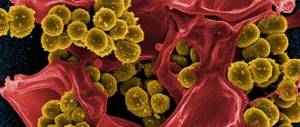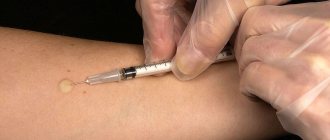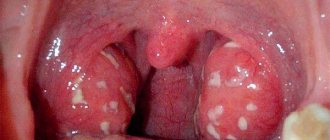Chronic runny nose or rhinitis is accompanied by a structural restructuring of the nasal mucosa, as a result of which a person experiences difficulty in nasal breathing, mucus secretion or other signs of inflammation. The mucous membrane can grow, as in the case of hypertrophic rhinitis, or it can become thinner, which indicates an atrophic process. With chronic atrophic rhinitis, processes of mucosal degeneration develop; it atrophies over time.
It is clear that under such conditions the nasal cavity cannot perform its natural functions, primarily the secretion of mucus. There is very little of it, the mucous membrane dries out. This occurs due to a decrease in the number of goblet secretory cells that produce mucous substances. The ciliated epithelium itself, which performs a transport and protective function, also suffers. The primary type of this type of runny nose, which is usually called ozena, is found mainly in the countries of East Asia and Africa.
Causes of disease development and provoking factors
One of the main prerequisites for the development of chronic atrophic rhinitis is hereditary predisposition, which is explained by the high incidence rate among close relatives. Otolaryngologists also note that this form of the disease is not so much local as systemic. This means that atrophic processes predominate not only in the nose, but also in the gastrointestinal tract, oral cavity and other organs. It is obvious that immunological disorders and individual characteristics of the blood supply to the mucous membrane play an important role in the development of atrophy. This all primarily concerns primary rhinitis.
Other causes of the disease include:
- pollution of the environment, especially the air, with chemical compounds that irritate the mucous membranes of the respiratory tract;
- occupational hazards in the form of inhalation of pollutants or exposure to hot air;
- hormonal changes in the body;
- chronic diseases of other respiratory organs, such as the paranasal sinuses;
- past infectious diseases (scarlet fever, measles);
- smoking;
- anemia;
- lack of vitamin D;
- autoimmune diseases;
- radiation therapy;
- nasal cavity injuries;
- surgical interventions on the septum or nasal turbinates, as well as on any other structures in the nasopharyngeal cavity;
- diseases of the digestive system;
- long-term drug effects on the nasal mucosa, for example, with the abuse of nasal decongestants;
- eating disorders;
- the effect of stress factors.
Secondary atrophic rhinitis most often occurs after surgery on the ENT organs.
Causes of the disease
If we talk about the reasons due to which an atrophic runny nose of an infectious nature can develop, the most common bacteria are Klebsiella, Bordetella, Mycoplasma, and Pseudomonas aeruginosa. Other reasons include:
- heredity,
- unfavorable environment,
- lack of iron in the body and hypovitaminosis,
- abuse of alcohol, drugs, tobacco products,
- unhealthy diet
- uncontrolled use of vasoconstrictor drops,
- contact with chemicals,
- taking hormonal drugs,
- complications after operations on ENT organs,
- frequent stress, overexertion, psycho-emotional instability,
- work associated with hazardous production.
Atrophic type of rhinitis can also be caused by other diseases of the body:
- atrophic gastritis,
- gallbladder pathology,
- immunodeficiency,
- disruption of the endocrine system,
- autoimmune infections,
- rhinoscleroma,
- systemic lupus erythematosus,
- hormonal disorders,
- upper respiratory tract catarrh,
- metabolic disorder,
- nasal injuries (surgical, household),
- vasculitis
Research shows that secretory cell depletion is interrelated. For example, if dysfunction of the digestive organs is detected in the human body, then there is a high probability that this pathological process will after some time affect the organs of the upper respiratory tract.
Types of atrophic rhinitis
The disease can appear without any provoking factors, then we are talking about primary atrophic rhinitis. The extreme severity of this type of runny nose is considered to be ozena - the so-called fetid runny nose. Doctors suggest that the causative agent of the disease is Klebsiella ozena. But the mechanism of its development has not yet been fully studied. Iron deficiency in the body, leading to infected hyposiderosis, is also considered an important factor.
Secondary atrophic rhinitis occurs due to the action of provoking factors, for example, trauma to the nasal cavity, especially during operations.
Reference! Chronic atrophic rhinitis is also called “dry” runny nose, because the discharge is scanty, and nasal breathing disturbances are pronounced.
Also, atrophic rhinitis can vary in the prevalence of the process:
- limited;
- diffuse.
With limited inflammation, atrophy occurs mainly in the anterior parts of the nasal cavity and turbinates. In a diffuse process of degeneration, most of the nasal mucosa is subject to degeneration. Atrophy affects not only the epithelium of the mucous membrane and its glands, but also nerve endings, including olfactory receptors. The vessels themselves also become thinner, losing the ability to adequately respond to changes in air parameters and inflammation.
Types of atrophic lesions of the mucosa
If no measures are taken at the onset of the disease, the pathological process gradually gains strength and the ciliated epithelium degenerates into squamous epithelial tissue. At the same time, mucus secretion sharply decreases and chronic atrophic rhinitis develops.
The cause of atrophic rhinitis is most often an incompletely cured acute runny nose.
The transition from the subatrophic to the atrophic form is accelerated under the influence of various ENT diseases or surgical interventions, injuries and pathologies of an endocrine nature.
It happens that the disease develops without a previous inflammatory process. Culture of the mucous membrane for the presence of pathogenic bacteria such as Klebsiella ozena, Corynebacterium or Proteus vulgaris allows one to diagnose infectious atrophic rhinitis.
Based on its origin, dry rhinitis is divided into two types:
- primary;
- secondary.
Often the cause of dysfunction is a malfunction in the body’s hormonal system, which disrupts blood circulation in the secretory membrane and leads to its degeneration. In this case, primary atrophy of the mucosa develops. An illness formed as a consequence of other pathologies - most often acute rhinitis - is called secondary atrophic rhinitis.
The most dangerous and difficult to treat is considered to be a fetid runny nose - ozena. It cannot be eliminated with drops and sprays. With this type of atrophy, cartilage and bone deformations of the nose occur.
The causative agent of ozena is Klebsiella ozena. Multiplying in the nasal cavity, the bacterium emits a putrid odor, which is felt by others, but the patient himself is not at all bothered by the stench. The situation is explained by atrophy of the cells responsible for the sense of smell.
During ozena, an unpleasant odor emanates from the patient, which can be felt at a distance
Symptoms and treatment of atrophic rhinitis directly depend on the type of runny nose and the reasons that caused it.
Clinical picture of ozena
A feature of the course of ozena, in contrast to simple atrophic rhinitis, is the transition of the inflammatory process to the bone and cartilaginous part of the walls of the nasal cavity. As a result of atrophy, the nasal cavity expands. The disease is rare and occurs mainly in women.
The main complaints of patients with ozena:
- the presence of many dried green or yellowish crusts on the nasal mucosa;
- dry nose when breathing and itching;
- fetid characteristic odor from crusts and scanty discharge;
- difficulty in nasal breathing;
- impaired or complete absence of smell perception.
Important! Sometimes the atrophy process is not limited to the nasal cavity and moves to the nasopharynx, pharynx, trachea and larynx.
The disease occurs in several stages:
- initial;
- height;
- final.
The first stage begins with the onset of the disease, which most often occurs in childhood (about 7 years). Patients complain of the constant presence of discharge, which over time acquires an unpleasant odor and a greenish tint. Nasal breathing becomes difficult, and the general condition suffers from this: headaches, drowsiness, fatigue, sleep and appetite disorders.
During the heightened phase, patients note the appearance of many fetid crusts in the nose, which are difficult to remove. There is dryness in the nose and difficulty breathing, general symptoms progress. Nosebleeds occur periodically and the perception of smells is impaired.
In the terminal phase, the disappearance of the unpleasant odor, discharge and drying of crusts is noted. The stage is regarded as spontaneous recovery, but only from the characteristic symptoms of ozena. All signs of chronic rhinitis, unfortunately, persist. Completion of the process occurs around the age of 40 or later, depending on when the disease began.
What factors contribute to the emergence
Among the factors that provoke the occurrence of atrophic rhinitis are:
- hypovitaminosis, poor nutrition;
- heredity;
- poor ecology and air pollution;
- dystrophy and iron deficiency;
- occupational hazards, exposure;
- constant abuse of drops, debilitating the condition after operations;
- unsuitable climate, bad habits;
- psychogenic factors.
There are several theories of the occurrence of atrophic rhinitis, namely: genetic and constitutional causes, trophic and psychogenic problems, bacterial and endocrine. Often the cause of the disease is a weakened body.
Various gases and dust, chemical compounds in household cleaning powders and deodorants can have a detrimental effect on the nasal mucosa. This is why many people choose environmentally friendly products for their home. In childhood, atrophic rhinitis is rare. This is mainly a problem for adults over 30 years of age.
Ozena can occur in adolescents during puberty, and occurs more often in girls than boys. In children, the provoking factor may be unfavorable social living conditions, poor nutrition, hormonal disorders, and psychological factors. Injuries to the nose can also affect the problem. Nasal surgery and other interventions may also be the cause. When affected in infancy, the problem lies in heredity. Ozena disease is characteristic of hot and dry climates.
Video on the topic:
[smartcontrol_youtube_shortcode key=”causes and prevention of rhinitis” cnt=”3" col=”3" shls=”false”]
Symptoms of secondary atrophic rhinitis
The process develops over a long period of time, the symptoms increase gradually. Dry nose and difficulty breathing appear. Due to the decrease in the amount of natural secretions, rough, yellowish crusts quickly form. Often patients are bothered by severe itching in the nose. Over time, the sense of smell deteriorates, but most often it does not completely disappear, unlike ozena.
Thinned vessels bleed easily, especially when trying to remove dried crusts. Due to atrophy processes, the nasal passages expand. Sometimes the mucous membrane and cartilage become so thin that a perforation of the nasal septum can occur.
Conclusion
Dystrophic changes in the nasal mucosa during atrophic rhinitis are fraught with serious consequences (bleeding, perforations, ulcerations of the nasal mucosa). And ozena not only harms health, but also destroys personal life. In Germany, during the Renaissance, the church easily divorced spouses if one of them was diagnosed with this unpleasant disease. Fortunately, this extreme form of pathology is now rare. It is impossible to identify and cure atrophic rhinitis on your own. If the described symptoms appear, you should contact an otolaryngologist for complete and long-term therapy. Physiotherapy will be prescribed by a physiotherapist.
Atrophic rhinitis in children
The appearance of atrophic rhinitis in children is associated with almost the same factors as in adults. A special role is played by congenital anomalies of the development of the facial skull and nasal cavity in the form of wide nasal passages. Hereditary predisposition, immune disorders, iron and vitamin deficiency are also important.
Ozena sometimes starts in childhood. Most often this occurs during puberty, which suggests the involvement of hormonal disorders in the development of the disease. If the initial stage occurs before puberty, then during puberty the symptoms usually worsen. Patients may strongly feel an unpleasant odor emanating from their nasal cavity, and then gradually stop complaining about it. This indicates a decrease in the sensitivity of the olfactory analyzer to odors due to receptor atrophy.
A child with atrophic rhinitis almost always has a slightly open mouth due to impaired breathing; such children have low weight due to decreased appetite, and often suffer from viral infections. There is also a decrease in intellectual capabilities, which affects the child’s academic performance. Since the facial skeleton continues to form in childhood, under the influence of atrophy the nose can acquire a saddle shape.
How does atrophic rhinitis differ from subatrophic rhinitis?
Subatrophic and atrophic rhinitis is an inflammatory process of the nasal mucosa, in which partial or complete tissue atrophy occurs. Atrophy refers to a decrease in the volume of mucosal cells along with the cessation of their functioning.
Tissue damage occurs gradually, but affects all areas:
- the cilia of epithelial cells disappear, which leads to a decrease in the purification of air entering the body;
- some of the mucosal tissue degenerates into scar tissue, which contributes to its compaction and expansion of the nasal passages;
- thinning of blood and lymphatic vessels occurs;
- the sensitivity of the nerve endings responsible for the sense of smell decreases;
- in severe cases, thinning of the bone tissue of the nose occurs.
Subtrophic rhinitis is characterized by a milder course. The nasal mucosa was slightly damaged. Often the development of this form of the disease is associated with insufficient nutrition of the nasal mucosa due to various internal and external factors, such as:
- long stay in rooms with dry air;
- disturbances in the functioning of internal organs (stomach, intestines, liver, kidneys);
- diseases of the central nervous system.
Atrophic rhinitis is characterized by more serious damage to the mucous membrane, including changes in the structure of bone tissue, dilation of the nasal passages, and loss of smell.
The development of the atrophic form of the disease is associated with a number of reasons:
- diseases of the gastrointestinal tract, biliary tract, liver;
- infectious diseases;
- nasal injuries;
- consequences of operations (removal of polyps, adenoids, plastic);
- hereditary predisposition;
- long-term treatment with vasoconstrictor drugs;
- exposure to dirt, dust, chemicals or gases.
In children, the development of atrophic rhinitis is also associated with other reasons:
- deficiency of vitamins A, D and microelements;
- improper and insufficient nutrition;
- hormonal disorders;
- psycho-emotional stress.
Diagnostics
Diagnosis of the disease is based on complaints, medical history and otolaryngological examination data. The simplest method is rhinoscopy. The doctor can see a pale, thinned mucous membrane with translucent vessels that bleed easily when touched with an instrument. An abundance of yellowish, gray or green crusts is visualized, which smell unpleasant during autumn. With a long course, there is an increase in the width of the nasal passages, sometimes so significant that upon examination you can see the back wall of the pharynx.
In addition to rhinoscopy, which is performed using mirrors, an ENT doctor may recommend a video endoscopic examination method, which allows a more detailed study of the structure of the nasal cavity. You will also need a bacterial culture of nasal discharge with an antibiogram. A test for the sensitivity of the olfactory analyzer is required. To exclude a chronic process in the paranasal sinuses and assess the condition of the bones of the nasal cavity, radiography, CT or MRI can be used.
Symptoms of the disease
Atrophic rhinitis has quite specific symptoms, so the disease is difficult to confuse with other pathological processes in the nasal cavity. The patient may feel anxious due to abnormalities such as:
- sudden lightening of the nasal mucosa;
- the appearance of dry green-yellow crusts in the nose;
- dry sensation in the sinus passages;
- clots of mucus are released with the blood.
Treatment
The treatment process for atrophic rhinitis is long and requires persistence on the part of the patient. Determining the cause of the disease plays an important role in choosing a treatment method for secondary dry runny nose.
Conservative therapy
Rinsing the nasal cavity with saline solutions is used for any type of chronic atrophy. This allows you to moisturize the mucous membrane and soak dried crusts for their subsequent safe removal. For this purpose, you can use an isotonic solution of sodium chloride or solutions of sea salt in the form of drops (Aqua Maris, Aqualor) and sprays (Humer, Marimer). Irrigation of the nasal cavity should be carried out 5-6 times a day or more often.
The easiest way to remove crusts is after rinsing the nose and first inserting cotton swabs with vegetable oils into the nasal passages. To do this, you can use olive, sea buckthorn, and peach oil, which help not only soften the crusts, but also promote the healing of damage to the mucous membrane.
To deodorize the nasal passages during ozena in order to eliminate the unpleasant odor, rinse with a 3% solution of hydrogen peroxide and a slightly pink solution of potassium permanganate is used. You can also use chlorophyll-carotene paste in the form of suppositories. Your doctor may perform the Gottstein tamponade procedure. To do this, gauze turunda is moistened with an iodine-glycerin mixture and inserted into the nasal passages for several hours. After which the turundas are removed, and with them the dried crusts.
In case of confirmed chronic sinusitis or a bacterial process, which most often occurs with ozena, antibacterial therapy is prescribed taking into account the sensitivity of the pathogen to antibiotics. Use tetracycline, chloramphenicol, streptomycin in the form of inhalations or ointments. Sometimes systemic use of antibiotics (Amikacin, Ciprofloxacin) or the introduction of their solutions into the maxillary sinus is required when it is affected by ozena.
Attention! Antibiotics should only be prescribed by an ENT doctor.
Local treatment also includes the use of agents to activate metabolic processes in the mucous membrane. Previously, preparations of silver, iodine, phenol, and ichthyol were used for this purpose. However, it is now noted that with prolonged use, atrophy may even worsen. Sometimes Lugol's solution is instilled into the nasal passages. As an alternative, regenerating ointments and gels based on solcoseryl (Actovegin) or solutions of vitamins A and E are used. A local immunostimulant based on bacterial lysates, spray IRS19, is also used. Some doctors recommend using multicomponent ointments based on riboflavin, ATP, sodium salt of CMC, humisol.
Pinosol and Sinusan oil drops have also proven themselves well. Mucolytic-based products effectively cope with the problem of thick mucus, thinning it (Rinofluimucil).
General treatment involves the use of biogenic stimulants (aloe, vitreous, trimetazidine, potassium orotate) and agents to improve blood circulation (pentoxifylline, xanthinol nicotinate). In case of iron deficiency, preparations based on it are used in combination with multivitamins.
Surgical interventions
If conservative methods are ineffective, surgical interventions are performed to improve nasal breathing:
- narrowing of the nasal passages by suturing special grafts under the mucosa or introducing certain substances;
- reconstructive operations on the walls of the nasal cavity and plastic surgery of the perforated opening of the nasal septum;
- placement of an Ivalon implant into the nasal septum to stimulate autonomic nerve endings;
- the formation of an anastomosis between the lacrimal sac or duct of the parotid salivary gland with the nasal cavity for additional hydration of the mucous membrane.
The last two types of surgical interventions are used to treat ozena.
Physiotherapy
These methods have a positive effect on blood circulation and regeneration processes of the mucous membrane in atrophic rhinitis. Successfully used:
- Ural Federal District;
- electrophoresis with nicotinic acid, proteolytic enzymes, potassium iodide;
- laser therapy;
- magnetic therapy;
as well as inhalations with mucolytics, essential oils and alkaline solutions to soften the crusts.
Traditional methods
Alternative medicine offers several methods of combating atrophic rhinitis for local treatment:
- rinsing the nasal cavity with a salt solution, decoctions or infusions of medicinal herbs: chamomile, calendula, sage (1 tablespoon of dry mixture per glass of boiling water);
- treatment of the nasal mucosa with sea buckthorn and olive oil, 1-2 drops several times a day to heal and soften crusts;
- the use of intranasal turundas with rosehip or sea buckthorn oil, which are administered for 30 minutes.
You can also use garlic oil to speed up the regeneration of the mucous membrane. To prepare it, take a teaspoon of olive oil and 3 drops of garlic juice. Inject 2-3 drops into each nostril several times a day.
Several types of decoctions are used for oral administration:
- mix rose hips, raspberries, lingonberries, black currants in equal parts and take one tablespoon and brew with 1 glass of boiling water, leave for 40 minutes to cool. Take a third of a glass after meals 3 times a day;
- black currants, nettles and rose hips are mixed in a ratio of 1:3:3 and boiled in 0.5 liters of boiling water for 10 minutes. Then infuse for 60 minutes. Take 0.5 cups three times a day.
Sea kale is a well-known stimulator of regeneration and immune reactivity in the body, so for chronic atrophic rhinitis it is recommended to eat it in the form of salads or dry powder. Dried kelp is taken 0.5-1 teaspoon in the evening. The product is washed down with water. The course of treatment lasts from 1 to 2 weeks.
How to treat atrophic rhinitis at home
In most cases, therapy does not require hospitalization. A patient on an outpatient basis can undergo treatment prescribed by a doctor: take antibiotics or other medications, put drops in the nose, perform inhalations, etc. Basic procedures that are easy to do at home:
- Clearing crusts in the nose. For the procedure, use a solution of chlorophyllipt or vegetable oils. A couple of drops are dissolved in a small amount of water. Then turundas are moistened in it, which are inserted into the nasal passages for a couple of minutes. Sea buckthorn, peach and eucalyptus oils are suitable.
- Rinse the nasal passages. To do this, mix 1 tbsp. water and 1 tsp. regular or sea salt. The resulting solution is used to wash the nasal passages up to 3 times every day, which helps to mechanically clean them of crusts. It is important to wait until all the salt crystals dissolve, otherwise you may injure the mucous membrane. For the procedure, you can use a syringe without a needle or a small enema. The water should be warm and boiled.
- Lubricating the nostrils with olive or sea buckthorn oil. The procedure is carried out using a cotton swab. It is moistened in the selected vegetable oil, and then lubricated from the inside of each nostril.
- Putting drops into the nose. Doctors often prescribe drugs such as Nazivin and Otrivin. For atrophic rhinitis, these drops have a vasoconstrictor effect, and therefore relieve congestion.
Folk remedies
Alternative medicine recipes are used both locally and internally. The following folk remedies have good reviews:
- Rosehip oil. It is instilled into each nostril up to 3 times a day. for 2-3 weeks. This helps prevent foul-smelling crusts from forming.
- Herbal decoction. You need to mix 1 tbsp. l. dried rose hips, black currant leaves and nettles. Next 1 tbsp. l. collection pour 2 tbsp. water, boil and simmer for 10 minutes. Infuse the product for at least 1 hour. Drink up to 3 r. per day 0.5 tbsp. throughout official treatment.
- Infusion of calendula or chamomile. Take 1 tsp. dry raw materials, brew a glass of boiling water and let cool. Rinse your nose with the resulting solution up to 5-6 times throughout the day. Repeat the procedure until crusts stop forming.
- Tea with ginger. Grate its root to make 1 tbsp. l. Pour 0.5 liters of boiling water over it, add 1 tsp. ground cinnamon and 2 tsp. pureed cranberries. Leave the product for 20 minutes. Drink 3 times a day before meals. You can drink tea without any time restrictions.
Complications of the disease
Atrophic rhinitis can be complicated by:
- sinusitis of various localizations;
- perforation of the nasal septum;
- laryngitis, tracheitis, bronchitis or pneumonia;
- otitis media with chronic process and subsequent hearing loss;
- conjunctivitis, keratitis;
- disorders of the digestive tract;
- trigeminal neuralgia;
- meningitis.
Depressive disorders, decreased memory and concentration are also common complications of the disease, which is associated with a violation of the patient’s quality of life.
Description
Chronic rhinitis is an inflammatory lesion of the nasal mucosa, which is accompanied by a constant runny nose. This is one of the most common diseases. According to statistics, it is present in 27% of the world's population. Moreover, these numbers are constantly increasing. Thus, over the past 30 years, chronic rhinitis in children has become diagnosed 2 times more often. Otolaryngologists claim that this is due to the deteriorating environmental situation in the world. Chronic rhinitis occurs somewhat more often in women than in men. There is the following classification of chronic rhinitis:
- Hypertrophic - leads to the growth of the nasal mucosa and subsequently to difficulty in nasal breathing.
- Atrophic - accompanied by atrophy of the nasal mucosa and nerve endings;
- Allergic. Pathological processes in the nasal cavity occur as a result of allergens entering the mucous membrane. As a rule, this form of rhinitis occurs in a person regularly in the same season (the time of flowering of certain plants).
- Vasomotor - symptoms of pathology arise as a result of dysregulation of the tone of blood vessels located in the nasal mucosa.
- Catarrhal - inflammation of the nasal mucosa occurs quite rapidly over a long period.
Symptoms of chronic rhinitis can vary greatly depending on the reasons that caused it and the individual characteristics of the body. That is why you should not engage in self-medication and self-diagnosis. If you suspect chronic rhinitis, you need to contact a therapist, and he, in turn, will refer the patient to the most appropriate specialist (usually an otolaryngologist, allergist or neurologist).
Causes of chronic rhinitis
There are many reasons for the development of chronic rhinitis. The main ones include:
- Disturbances in the structure of the nose, for example its curvature (congenital or acquired).
- Frequent relapses of acute rhinitis.
- Exposure to various irritating substances on the nasal mucosa for a long time (for example, inhalation of dust). Thus, mineral dust can cause mechanical damage to the mucous membrane, and chalk dust can lead to the death of cilia. In severe cases, dust can accumulate in the nasal cavity and cement there, forming nasal stones - rhinoliths. Inhaling steam can also injure the mucous membranes and lead to severe inflammation.
- Physical factors, such as inhaling too cold air (disturbs the tone of the vessels located in the nose).
- The presence of a pathological process in the paranasal sinuses and/or throat (sinusitis, sore throat).
- Allergic reactions.
- Circulatory disorders.
- Long-term use of certain medications. For example, vasodilators for high blood pressure or vasoconstrictor drops for colds. Therefore, it is not recommended to use such drops for longer than a week.
Prognosis and consequences of chronic rhinitis
The prognosis of chronic rhinitis (if it was diagnosed on time and treated correctly) is usually favorable. In most cases, for the patient to recover, it is enough to eliminate the underlying cause of the disease. In patients who do not treat chronic rhinitis, complications usually include the following:
- inflammatory lesions of the upper respiratory tract and/or sinuses;
- inflammation of the inner ear and/or auditory tube;
- inflammation of the tissues surrounding the eyeball;
- dermatitis in the nose area.
In severe cases, complete loss of the ability to distinguish odors is possible.
The information is for reference only and is not a guide to action. Do not self-medicate. At the first symptoms of the disease, consult a doctor.
Prevention
It is difficult to prevent the development of the disease, but contact with harmful substances through the respiratory tract should still be avoided:
- no smoking;
- in case of occupational hazards, use respiratory protection;
- minimize the use of deodorants and air fresheners in enclosed spaces.
To humidify the air, you can use a household humidifier, which will also be useful for people already diagnosed with atrophic rhinitis. If the disease already exists, its progress should be prevented by regularly irrigating the nose with saline solution, and when humidity drops, lubricate the mucous membrane with glycerin or sea buckthorn oil. Be sure to eat right and lead a healthy lifestyle.
Thus, the treatment of atrophic rhinitis is long and not always successful, but with an integrated approach it allows, if not to stop the atrophy process, then at least to alleviate the patient’s condition.
What changes occur with atrophic rhinitis
It is worth remembering that this disease itself brings a lot of inconvenience to both those around you and the patient himself. Therefore, its symptoms are simply impossible not to notice and not to begin treatment on time. True, treatment of this disease is not always successful. That is why you should consult a doctor at the first signs of illness.
The main manifestation of this disease is that the ciliated epithelium gradually degenerates into flat epithelium and completely ceases to perform its functions. In the mucous membrane, the number of blood vessels decreases and it becomes thinner, the cilia on it gradually begin to fall out, and the secretion of mucous secretion completely stops. On the other hand, for the same reason, the fight against microbes and viruses from the environment stops.
All this gradually leads to the accumulation of dead epidermal cells, bacteria and viruses on the nasal mucosa, and the surface of the mucous membrane itself dries out. These processes ultimately lead to decay and infection.
Doctors did not fully understand the reason, but either due to a decrease in the number of blood vessels or because endocrine regulation is disrupted, nutrients completely stop entering the mucous membrane and it begins to die. But she cannot recover.
If treatment for rhinitis is not started, the disease spreads to the bone tissue of the nose. And layer by layer the bone begins to deteriorate.
The main cause of atrophic rhinitis is considered to be an untreated runny nose that has become chronic. As a result, the nutrition of the mucous membrane was disrupted due to the constant inflammatory process. This disease becomes chronic due to the following factors:
- Warm and dry air in the room where the patient is.
- Excessive presence of pollutants in the air.
- Constant irritation of the nasal mucosa by chemicals.
In addition, this disease can develop against the background of frequent allergic rhinitis and constant use of vasoconstrictor drugs, the so-called medicinal rhinitis. So, if, with a chronic runny nose, the cilia begin to die, then one should suspect atrophy of the nasal mucosa.
But in the initial stages the disease is still reversible. Eyelashes can recover if all pathogenic flora and all factors that negatively affect the mucous membrane are removed. But it is worth remembering that the disease can progress faster if the patient smokes or drinks alcohol, and the atrophy is also accelerated by frequent sinusitis and adenoiditis. But such rhinitis will be called secondary, because it occurs against the background of an existing illness.
Treatment methods
Treatment of atrophic rhinitis in any person should always be carried out under the supervision of an otolaryngologist. Independent use of various recipes can aggravate the course of the disease and then surgical intervention will be required for a complete recovery. Traditional methods for the treatment of atrophy of the mucous layer can be used, but only along with the official course of treatment as an auxiliary therapy.
Drug treatment is divided into general and symptomatic . General treatment includes a course of vitamins and microelements; the patient must be prescribed a nutritious diet, and, if necessary, iron and iodine supplements. That is, the general course should be aimed at increasing the body’s defenses and rapid recovery.
Symptomatic treatment includes:
- Oil-based nasal drops and therapeutic aerosol inhalations. Their use is necessary to soften the crusts and make them easier to remove. Used for softening and ointments - lanolin, vaseline, mercury.
- Use nasal suppositories made from chlorophyll-carotene paste.
- If there are purulent crusts, wash the nose with antimicrobial agents or insert tampons soaked in peach, sea buckthorn, and olive oil.
- For severe ulcerations on the mucous membrane, the doctor prescribes ointments that improve metabolism and accelerate regeneration, for example, Solcoseryl ointment.
- Physiotherapeutic procedures are indicated.
- If infectious atrophic rhinitis is detected, a course of antibiotics must be selected.
Surgical intervention and folk remedies
Surgical treatments are used only if conservative therapy has failed. Basically, an operation is performed in which a mechanical narrowing of the nasal passages is achieved, as a result of which the formation of fetid crusts is reduced.
Among folk remedies, doctors advise using rinsing of the nasal passages with decoctions of anti-inflammatory herbs. Olive oil softens dry crusts well; when warm, it is instilled into the nose, two to three drops at a time. With the help of folk recipes, one can strengthen the immune system in various ways, which will also have a beneficial effect on the outcome of treatment.
Atrophic rhinitis is a disease that affects not only general well-being, but also a person’s mood and ability to work. It is impossible to delay the treatment of this pathology; only quickly selected and competent therapy will help restore the structure of the mucous layer of the nasal passages.
Next articles:
- Nasal sprays for runny nose: the most effective sprays, prices, rules of use
- Nasal drops for a runny nose: types, drops for children and pregnant women
- Nebulizer for the nose: use, medications, contraindications
- Complications of rhinitis: causes and consequences
- Bleeding from the nose due to a runny nose (rhinitis)
- Runny nose in a newborn: what to do, how to treat?
- Rhinitis: treatment with traditional methods
- Snot without cough and fever: causes, methods of treatment
Preventive measures
The disease is easier to prevent than to treat, so you must follow simple rules of prevention:
- hygiene of the nose and mouth;
- timely treatment of diseases of the teeth and gums, sinuses, and pharynx;
- active hardening, increasing immunity;
- proper nutrition, including all necessary microelements and vitamins;
- maintaining cleanliness in the room.
You need to lead a healthy lifestyle and give up bad habits forever.
Are as follows:
- Monitoring the hygiene of the nasal and oral cavity;
- Timely treatment of diseases of the oral cavity, paranasal sinuses, and pharynx;
- Hardening;
- Nutritional balance;
- Keeping your home clean.
Breathing exercises play an important role in preventing rhinitis. It will only take a couple of minutes, but it should be performed regularly: several times daily.
- Take a comfortable position so that your back remains straight.
- We place the fingers of one hand according to the diagram: the index finger rests on the bridge of the nose, the thumb on the right wing of the nose, the middle finger on the left wing.
- We exhale fully through the nose, after which we pinch the right nasal passage with our thumb.
- Exhale through the left nostril for 4 seconds and then close it.
- We hold our breath for 8-10 seconds, then open the right nasal passage and slowly exhale.
You need to remember that the duration of exhalation is 2 times longer than the duration of inhalation.
After the manipulations, you should take a short break of about 10 seconds and begin working with the left nasal passage. You need to do 5 approaches for each nostril.
Prevention of the described disease comes down to the following actions:
- active leisure and healthy lifestyle;
- strengthening the immune system and proper fortified nutrition;
- eliminating bad habits;
- Carrying out regular care of the nasal cavity with solutions based on sea salt;
- timely treatment of viral and bacterial infections;
- use of respiratory protection equipment in hazardous industries;
- regular cleaning and maintaining optimal temperature and humidity in the room.
Atrophic rhinitis is a serious disease of the nasal cavity, which is fraught with serious consequences: bleeding, perforations, various distortions of the nose and face. It is impossible to recover from this disease on your own. Qualified therapy for the disease is lengthy and not always successful. Therefore, when the first symptoms appear, do not delay treatment and get examined by an otolaryngologist to avoid complications.












